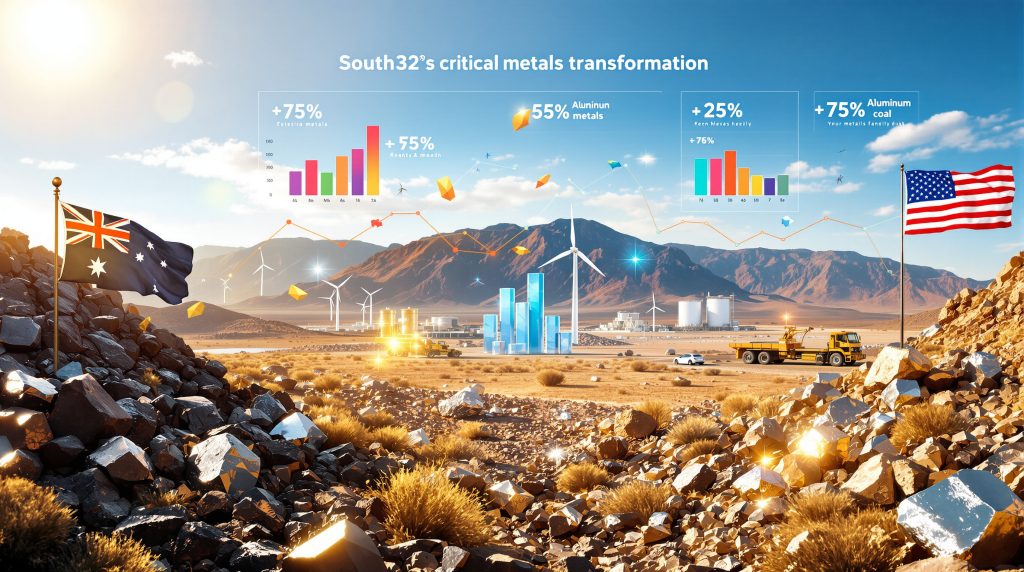How Critical Metals Position South32 for Energy Transition Success
South32 has undergone a remarkable transformation since its 2015 demerger from BHP, evolving from a traditional mining company with significant coal exposure into a diversified critical metals producer. This strategic shift positions the company at the forefront of the global energy transition, with operations focused on materials essential for renewable energy infrastructure, electric vehicles, and clean technology manufacturing.
The company's portfolio now centers on commodities that are fundamental to decarbonization efforts worldwide. Unlike many large-cap miners that remain heavily exposed to iron ore or petroleum, South32 has deliberately cultivated exposure to critical metals in South32 mining operations that directly support electrification and renewable energy deployment. Furthermore, this approach aligns with the broader critical minerals energy transition currently reshaping the mining sector.
What Critical Metals Does South32 Currently Produce?
South32's critical metals portfolio spans three primary categories: manganese, zinc, and aluminium value chain products. Each plays a crucial role in the energy transition landscape.
Manganese: The Overlooked Battery Component
South32 controls approximately 10% of global seaborne manganese supply through its GEMCO operation in Australia's Northern Territory. The facility produced 3.6 million tonnes of manganese ore in FY2024, making it one of the world's most significant manganese suppliers.
Manganese serves dual purposes in the energy transition:
- Battery cathodes: Essential for lithium manganese oxide (LMO) and nickel manganese cobalt (NMC) battery chemistries
- Steel strengthening: Critical for infrastructure supporting renewable energy installations
- Supply security: Addresses U.S. import dependence, with America sourcing 100% of manganese requirements from foreign suppliers
The GEMCO operation maintains proven and probable ore reserves of 134 million tonnes at 43% manganese grade, providing decades of production capability. This reserve base represents substantial value given manganese's critical mineral designation by the U.S. government.
Zinc Production Across Multiple Jurisdictions
The Cannington mine in Queensland stands as one of the world's largest silver-lead-zinc operations by production volume. In FY2024, Cannington delivered:
- 89,000 tonnes of zinc in concentrate
- 6.2 million ounces of silver as by-product
- Consistent production from a world-class orebody
Zinc's importance extends beyond traditional applications. The International Zinc Association reports that approximately 50% of zinc consumption supports galvanizing steel, which provides corrosion resistance essential for renewable energy infrastructure. Solar panel mounting systems and wind turbine structures rely heavily on galvanized steel components for long-term durability in outdoor environments.
Aluminium Value Chain Integration
South32 maintains significant exposure across the aluminium supply chain through operations spanning three continents:
| Operation | Location | FY2024 Production | Ownership |
|---|---|---|---|
| Worsley Alumina | Western Australia | 3.9 million tonnes | 86% |
| Brazil Alumina | Brazil | 1.2 million tonnes | 100% |
| Mozal Aluminium | Mozambique | 265,000 tonnes | 47.1% |
This lightweight metal forms the backbone of renewable energy infrastructure, serving as the primary material for solar panel frames, wind turbine components, and electric vehicle body structures. Consequently, the geographic diversification provides operational resilience while exposing the company to varying regulatory environments.
How Will the Hermosa Project Transform South32's Critical Metals Profile?
The Hermosa project in Arizona represents a pivotal development for both South32 and U.S. critical minerals security. This operation will become the only advanced-stage mining development in the United States capable of producing two federally-designated critical minerals: manganese and zinc.
Arizona's Strategic Mining Development
Located in Arizona's Patagonia Mountains, Hermosa received Fast-41 permitting designation under the Federal Permitting Improvement Steering Council, streamlining regulatory approval processes for strategically important projects. This designation reflects the project's significance for domestic supply chain security, particularly in light of the recent US critical minerals order emphasising domestic production.
The Taylor Deposit contains proven and probable reserves of 56 million tonnes at 9.4% zinc equivalent, while the Clark Deposit holds mineral resources of 278 million tonnes at 10.2% manganese. These substantial resources provide the foundation for long-term production capability.
Production Timeline and Scale
South32 made the final investment decision for Hermosa in February 2024, triggering a construction timeline leading to:
- First production: Second half of 2027
- Full production capacity: 3 million tonnes annually by 2031
- Mine life: 28 years for initial Taylor Deposit
- Capital investment: US$2.16 billion over construction phase
The project economics demonstrate attractive returns with a post-tax net present value of US$686 million and internal rate of return of 12%. These metrics support the investment case for developing domestic critical minerals production.
Domestic Supply Chain Implications
Hermosa addresses critical vulnerabilities in U.S. supply chains by establishing domestic production of materials previously sourced entirely from imports. According to the U.S. Geological Survey, America currently imports:
- 100% of manganese requirements (primarily from Gabon, South Africa, and Australia)
- Significant zinc imports to supplement domestic production
The U.S. Inflation Reduction Act provides additional support through tax incentives, including the Advanced Manufacturing Production Credit offering up to $35 per kilogram for domestically produced critical minerals.
Which Operational Challenges Have Impacted South32's Critical Metals Output?
Despite its strategic positioning, South32 faces operational challenges that highlight the vulnerabilities inherent in critical minerals supply chains.
Cyclone Disruptions in Northern Territory
Cyclone Megan struck the Northern Territory in March 2024, causing significant disruptions at the GEMCO manganese facility. The Category 3 cyclone forced operations to suspend for several weeks, demonstrating the vulnerability of critical mineral supply chains to extreme weather events.
The impact included:
- 8% reduction in FY2024 manganese ore production compared to FY2023
- Several months of recovery time to restore full operations
- Approximately US$150 million in EBITDA impact from operational disruptions
Northern Australia experiences an average of 4-5 tropical cyclones per season, with Category 3 events like Cyclone Megan occurring approximately once every 5-10 years in the Groote Eylandt region. This frequency underscores the need for enhanced resilience planning in critical minerals operations.
Power Supply Constraints in Mozambique
The Mozal Aluminium smelter faces potential care and maintenance status due to chronic power supply instability. South32 announced a US$372 million impairment charge in August 2024, reflecting the challenges of maintaining aluminum production in regions with unreliable energy infrastructure.
Key factors affecting Mozal operations:
- 900 MW continuous power requirement for smelter operations
- Mozambique's installed capacity of approximately 2,600 MW versus peak demand exceeding 3,000 MW
- Production decline from 286,000 tonnes in FY2023 to 265,000 tonnes in FY2024
The World Bank's Mozambique Energy Sector Report highlights that energy reliability remains a critical constraint for industrial operations in sub-Saharan Africa, with the country ranking in the bottom quartile for power supply reliability.
Jurisdictional Risk Management
South32's geographic diversification provides operational resilience but exposes the company to varying levels of political stability and regulatory environments. The Fraser Institute's Annual Survey of Mining Companies ranks jurisdictions by investment attractiveness:
- Australia: 4th globally for investment attractiveness
- United States: Top-tier mining jurisdiction
- Mozambique: 58th out of 62 jurisdictions surveyed
This risk distribution balances growth opportunities in emerging markets with operational security in stable jurisdictions, reflecting the company's evolving critical minerals strategy.
What Role Do Critical Metals Play in South32's Revenue Transformation?
The shift toward critical metals has fundamentally transformed South32's financial profile since its 2015 demerger from BHP.
Portfolio Evolution Since Demerger
At the time of demerger, South32's asset portfolio included significant thermal coal exposure through Illawarra Coal and South Africa Energy Coal. Coal represented approximately 23% of group EBITDA in FY2015.
By FY2024, the revenue composition had shifted dramatically:
| Commodity Segment | FY2024 Revenue | Percentage of Total |
|---|---|---|
| Aluminium | US$2.45 billion | 41% |
| Manganese | US$1.37 billion | 23% |
| Base metals (Zn, Pb, Ag) | US$1.14 billion | 19% |
| Other operations | US$1.02 billion | 17% |
| Total Revenue | US$5.98 billion | 100% |
This transformation positions South32 with approximately 83% of revenue from commodities classified as energy transition-exposed, compared to major diversified miners like BHP where iron ore represents approximately 54% of revenue.
Margin Improvement Through Portfolio Optimization
The strategic shift has enhanced profitability metrics:
- FY2024 Underlying EBITDA margin: 31.8%
- FY2015 EBITDA margin: 28.4%
- Carbon emissions reduction: 15% decrease in Scope 1 and 2 emissions intensity from FY2023 levels
Future Revenue Projections
Bloomberg consensus forecasts project revenue growth driven by Hermosa production ramp-up:
- FY2025: US$6.5 billion
- FY2026: US$6.3 billion
- FY2027: US$7.0 billion (reflecting Hermosa contribution)
- FY2028: Continued growth from expanded critical metals production
The projected EBITDA margins demonstrate sustained profitability: 26.2% (FY2025), 31.7% (FY2026), and 30.0% (FY2027).
How Does South32's Critical Metals Strategy Compare to Major Mining Peers?
South32's focused approach to critical metals in South32 mining operations differentiates it from traditional large-cap miners.
Differentiated Exposure Profile
Unlike Rio Tinto's iron ore focus or BHP's petroleum exposure, South32 concentrates on materials directly supporting electrification and renewable energy deployment:
South32 Commodity Mix:
- Aluminium value chain: 41% of revenue
- Manganese: 23% of revenue
- Base metals (Zn, Pb, Ag): 19% of revenue
- No iron ore or petroleum exposure
BHP Comparison:
- Iron ore: 54% of FY2023 revenue
- Copper: 21% of revenue
- Metallurgical coal: 14% of revenue
Rio Tinto Comparison:
- Iron ore: ~60% of FY2023 earnings
- Aluminium: ~24% of earnings
- Copper: ~11% of earnings
Valuation Metrics Analysis
South32's growth prospects are reflected in valuation metrics as of October 2024:
| Company | Market Cap (USD) | FY2026 P/E | EV/EBITDA | PEG Ratio |
|---|---|---|---|---|
| South32 | US$9.2 billion | 16.3x | 5.4x | 1.7x |
| Rio Tinto | US$124 billion | 10.4x | – | 12.5x |
| BHP | US$144 billion | 13.8x | – | – |
South32's PEG ratio of 1.7x suggests more attractive growth prospects relative to traditional mining peers, despite trading at a premium P/E multiple.
Geographic Risk Distribution
South32's operations balance stable jurisdictions with emerging market opportunities:
- Australia: 50% of assets by value (estimated)
- Americas: 30% (including Hermosa development)
- Africa: 20% (primarily Mozal operations)
This distribution contrasts with peers having heavier concentration in single jurisdictions or commodity types, particularly as the industry embraces data-driven mining operations to optimise performance across diverse geographic locations.
What Investment Implications Arise from South32's Critical Metals Focus?
Several factors support the investment thesis for critical metals exposure through South32.
Supply-Demand Fundamentals
Global critical metals demand faces structural growth drivers:
- Demand growth projection: 3-7x increase by 2030 due to renewable energy deployment
- Electric vehicle adoption: Accelerating demand for battery materials including manganese
- Grid infrastructure: Massive copper and aluminum requirements for transmission expansion
The International Energy Agency projects that demand for critical minerals could increase by up to six times by 2040 under stated energy policies, with even higher growth under net-zero scenarios.
Government Policy Support
Multiple jurisdictions are implementing policies supporting critical minerals development:
United States:
- Inflation Reduction Act tax incentives
- Critical Materials Strategy designation
- Fast-track permitting for strategic projects
Australia:
- Critical Minerals Strategy 2023-2030
- Export finance support for critical minerals projects
- Research and development incentives
These policy frameworks provide tailwinds for projects like Hermosa while supporting long-term demand visibility.
ESG Considerations
Critical metals mining presents both opportunities and challenges from an ESG perspective:
Positive factors:
- Supports global decarbonization objectives
- Enables renewable energy deployment
- Reduces dependence on geopolitically sensitive suppliers
Challenges:
- Mining operations inherently involve environmental impacts
- Social license requirements in local communities
- Water usage and waste management considerations
South32's approach includes low-carbon mine design, automation focus, and community engagement programs to address investor ESG concerns.
How Might Commodity Price Volatility Affect South32's Critical Metals Returns?
Critical metals in South32 mining operations often exhibit different price dynamics compared to traditional bulk commodities.
Price Correlation Analysis
London Metal Exchange data demonstrates varying volatility patterns:
- Zinc prices: US$2,500-3,500/tonne range over past 5 years
- Iron ore comparison: US$80-190/tonne range (wider volatility)
- Manganese: Less transparent pricing but generally less volatile than iron ore
Critical metals prices respond more directly to industrial demand and supply disruptions rather than broad economic cycles, providing different risk-return characteristics compared to bulk commodities.
Hedging and Risk Management
South32 employs selective hedging strategies:
- Selective hedging for base metals exposure
- Upside participation maintained in critical metals price appreciation
- Balance approach: Cash flow stability versus growth potential
This strategy recognizes that critical metals may experience different price cycles than traditional commodities, warranting flexible risk management approaches.
Long-term Contracting Opportunities
Critical metals producers increasingly secure long-term supply agreements with:
- Battery manufacturers requiring security of supply
- Renewable energy companies planning multi-year project pipelines
- Government stockpiling programs for strategic materials
These arrangements provide revenue visibility and reduce spot price exposure, particularly valuable for capital-intensive projects like Hermosa.
What Future Developments Could Enhance South32's Critical Metals Position?
Several potential developments could further strengthen South32's critical metals portfolio, particularly as the mining industry evolution continues to accelerate.
Exploration Pipeline Expansion
South32 maintains active exploration programs targeting critical minerals:
Key Projects:
- Ambler Metals JV (Alaska): Copper-zinc-lead-gold exploration with Trilogy Metals
- Jessica copper project (Northern Territory): Farm-in agreement with Encounter Resources
- Isa Valley Copper/Zinc: Early-stage exploration prospects
These programs provide optionality for expanding critical metals production beyond current operations and the Hermosa development.
Technology Integration Opportunities
Advanced mining technologies could improve operational efficiency:
- Automation systems: Reducing operational costs and improving safety
- AI-driven optimization: Enhancing extraction efficiency and ore recovery
- Remote monitoring: Minimizing weather-related disruptions through early warning systems
South32's operations in developed mining jurisdictions position the company to implement these technologies effectively.
Strategic Partnership Potential
Collaboration opportunities could accelerate development:
Potential Partners:
- Battery manufacturers seeking supply security
- Automotive companies requiring critical materials
- Government agencies supporting domestic production
Such partnerships could provide funding for expansion while securing long-term demand, similar to arrangements seen in other critical minerals projects globally.
The combination of existing production capabilities, the Hermosa development pipeline, and potential partnership opportunities positions South32 as a significant participant in the global transition toward clean energy infrastructure. The company's focus on critical metals in South32 mining operations aligns with structural demand growth while providing exposure to commodities less correlated with traditional economic cycles.
Investment Considerations: This analysis is for informational purposes only and should not be construed as investment advice. Critical metals investments involve commodity price volatility, operational risks, and regulatory uncertainties. Potential investors should conduct thorough due diligence and consider their risk tolerance before making investment decisions.
Ready to Capitalise on the Next Major Critical Metals Discovery?
Discovery Alert's proprietary Discovery IQ model delivers real-time alerts on significant ASX mineral discoveries, instantly empowering subscribers to identify actionable opportunities in critical metals and other high-potential sectors ahead of the broader market. Explore how historic discoveries have generated substantial returns and begin your 30-day free trial today to position yourself ahead of the market as the energy transition accelerates demand for critical minerals.




